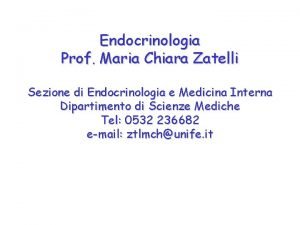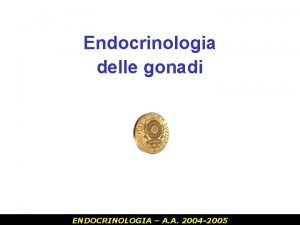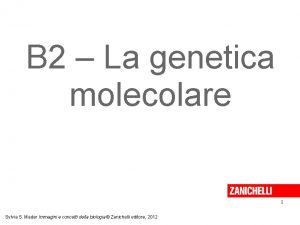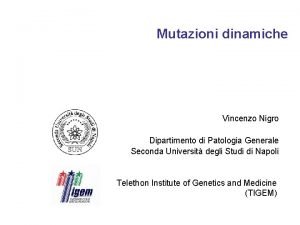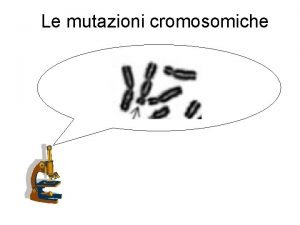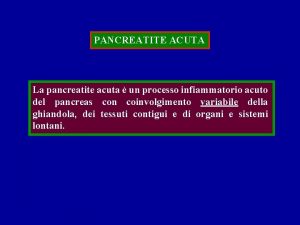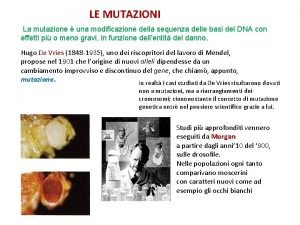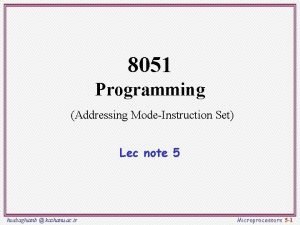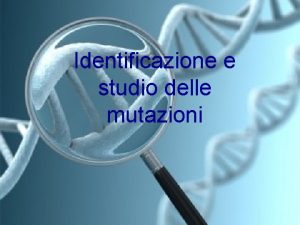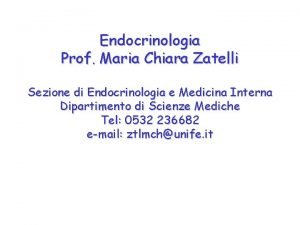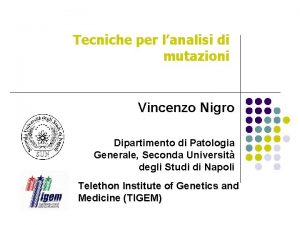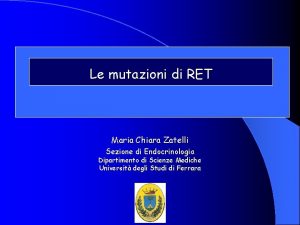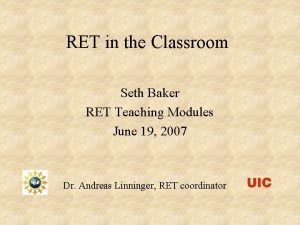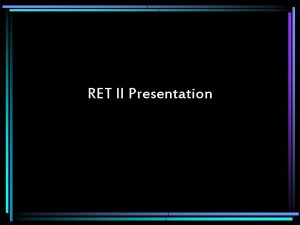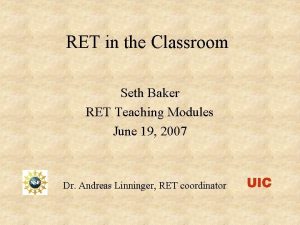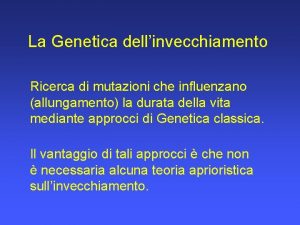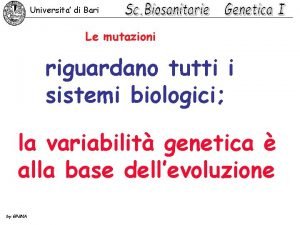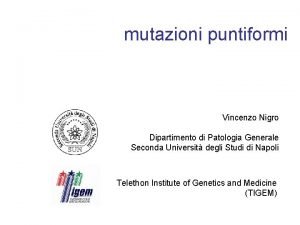Lanalisi di mutazioni di RET in Endocrinologia RET













































































- Slides: 77

L’analisi di mutazioni di RET in Endocrinologia

RET mutations in Endocrinology RET (REarranged during Transfection) protooncogene Long arm of chromosome 10 (10 q 11. 2) susceptibility gene for • familial medullary thyroid cancer (FMTC) • pheochromocytoma • parathyroid hyperplasia/adenomas multiple endocrine neoplasia type 2 (MEN 2)

RET mutations in Endocrinology RET transmembrane receptor extracellular domain transmembrane domain tyrosine kinase domain

RET mutations in Endocrinology RET dimerizes associates with GFR -1 forms the GDNF receptor (glial cell line–derived neurotrophic factor recepor, GDNF R) In the absence of GDNF, RET and GFR-1 do not dimerize

RET mutations in Endocrinology In the presence of GDNF the receptor complex is activated autofosforilation signal transduction pathway activation

RET mutations in Endocrinology Machens et al. 2009 J Intern Med 266: 114

RET mutations in Endocrinology

RET mutations in Endocrinology RET is expressed in several normal tissues

RET mutations in Endocrinology RET is expressed in several normal and neoplastic tissues

RET mutations in Endocrinology RET mutations constitutive supraphysiological activation of the RET receptor tyrosine kinase cell hyperstimulation thyroid C cells adrenal medullary cells parathyroid chief cells

RET mutations in Endocrinology ‘Gain-of-function’ mutations transmembrane domain codon 649 Least high transforming ability RET protein monomers are kept in close proximity to each other through noncovalent receptor–receptor interactions Machens et al. 2009 J Intern Med 266: 114

RET mutations in Endocrinology ‘Gain-of-function’ mutations cysteine-rich extracellular domains codons 515, 609, 611, 618, 620, 634 High transforming ability ligand-independent dimerization and crossphorylation of mutant RET receptor proteins loss of a cysteine residue irrespective of the amino acid substituting for cysteine addition of one more cysteine residue in codons 533, 606 or 631 Machens et al. 2009 J Intern Med 266: 114

RET mutations in Endocrinology Mutations in the Cystein-rich extracellular domain cause RET dimerization and autophosphorylation, independently of the ligand

RET mutations in Endocrinology ‘Gain-of-function’ mutations intracellular tyrosine kinase domain codons 768, 790, 791, 804 and 891 Very high transforming ability facilitate the access of ATP to its binding site preferential binding of intracellular substrate intracellular catalytic core codon 918 Machens et al. 2009 J Intern Med 266: 114

RET mutations in Endocrinology Mutations in the intracellular kinase domain cause RET autophosphorylation, independently of dimerization and of the ligand

RET mutations in Endocrinology GENOTYPE-PHENOTYPE CORRELATION

RET mutations in Endocrinology MEN 2 A: MTC, hyperparathyroidism, pheochromocytoma (100% penetrance) MEN 2 B: MTC, pheochromocytoma, muco-cutaneous neuromas (98% penetrance) FMTC: MTC


RET mutations in Endocrinology Machens et al. 2009 J Intern Med 266: 114

RET mutations in Endocrinology Elisei et al. J Clin Endocrinol Metab 2007, 92(12): 4725– 4729

RET mutations in Endocrinology Machens et al. 2009 J Intern Med 266: 114 Cost-effective identification of affected family members Gilchrist et al. Clin Genet 2004; 66: 349– 53 legal and ethical importance indicating the need for prophylactic thyroidectomy gold standard of care Rosenthal et al Thyroid 2005; 15: 140– 5

RET mutations in Endocrinology Different forms of medullary thyroid cancer 5 th-6 th decade of life within 3 rd decade of life Elisei R 2008 Best Pract Res Clin Endocrinol Metab 22: 941– 953

RET mutations in Endocrinology Hereditary MTC Prospective family screening Germline RET mutations 95% of MEN 2 A kindreds Hirshprung disease Lichen amyloidosis 88% of FMTC kindreds >95% of MEN 2 B kindreds (codon 918) Elisei et al. 2007 J Clin Endocrinol Metab 92: 4725 -9 Castellone et al. 2008 Endocrinol Metab Clin North Am 37: 363 -74, viii

RET mutations in Endocrinology Hereditary MTC 6 -75% of “sporadic” MTC carry a germline RET mutation Elisei et al. 2007 J Clin Endocrinol Metab 92: 4725 -9 Wohllk et al. 1996 J Clin Endocrinol Metab 81: 3740 -3745 RET genetic testing should be encouraged in all newly diagnosed MTC patients The National Comprehensive Cancer Network Clinical Practice Guidelines in Oncology 2009 biochemical screening for MEN 2 hyperparathyroidims pheochromocytoma

RET mutations in Endocrinology Genetic screening in proband in first degree relatives is fundamental High likelihood of developing MTC during lifespan consider prophylactic thyroidectomy follow up

RET mutations in Endocrinology How is genetic analysis perfomed? 1. Patient referral for MTC or family history of MTC 2. History – evaluate family history 3. Clinical examination 4. Informed consent signature 5. Blood withdrawal (no fasting needed) 6. Sample sent to the Lab

RET mutations in Endocrinology amplificazione del DNA GENOMIC DNA DIRECT SEQUENCING denaturation purification DNA isolation purification Sequencing reaction Capillary electrophoresis

RET mutations in Endocrinology Comparison with the Electropherogram analysis normal sequence by any a Technicial SNP? by the Physicial in charge DIAGNOSIS

RET mutations in Endocrinology Risk level Risk RET genotype (mutation in codon) 3 Highest 883, 918, 922 2 High 634, 630, 609, 611, 618, 620 1 Least high 768, 790, 791, 804, 891 Brandi et al. 2001 J Clin Endocrinol Metab 86: 5658– 71 mutation site is one of the most important determining factors of risk and age-related penetrance of a specific RET mutation Moore et al. 2008 Pediatr Surg Int 24: 521– 530

RET mutations in Endocrinology

RET mutations in Endocrinology Sporadic MTC 40 -50% of sporadic MTC display somatic RET mutations Romei et al. 1996 J Clin Endocrinol Metab 81: 1619– 1622 Schilling et al. 2001 Int J Cancer 95: 62– 66 Zedenius et al. 1995 J Clin Endocrinol Metab 80: 3088– 3090 Zedenius et al. 1998 Cancer Detect Prev 22: 544– 548 Somatic RET mutations correlate with • presence of lymph node metastases at diagnosis • worse outcome • disease persistence after surgery • lower survival rate bad prognostic factor Elisei et al. 2008 J Clin Endocrinol Metab 93: 682 -7

RET mutations in Endocrinology

RET mutations in Endocrinology SURGERY total thyroidectomy with dissection of ipsilateral and central neck compartments ? contralateral dissection ? Sporadic MTC Hereditary MTC Asymptomatic RET mutation carriers before MTC occurrence undetectable CT levels in > 95% of cases Kouvaraki et al. Thyroid 2005 15: 531– 544

RET mutations in Endocrinology SURGERY Ideally, prophylactic thyroidectomy should be undertaken before MTC develops in children normal thyroid volume asymptomatic young Miccoli et al. J Endocrinol Invest 2004; 27: 557– 61 Miccoli et al. Surg Endosc 2007; 21: 120– 3

RET mutations in Endocrinology Hereditary MTC SURGERY codon 918 codons 609, 611, 618, 620, 634 codons 768, 790, 791, 804 and 891 Risk level Risk Surgery within 3 Highest within the first 6 months of life 2 High before 5 years of age Least high between 5 and 10 years of age 1 Falchetti et al. 2008 Best Pract Res Clin Rheumatol 22: 149 -63 aggressive neck dissection should be performed with lateral lymph node involvement

RET mutations in Endocrinology SURGERY Very early surgical intervention (<2 yr for exon 9187 mutations or <10 yr) no need for additional lymph node dissection Preserve parathyroid glands ≥ 10 involved lymph nodes autograft no surgical cure Machens et al. Cancer 2000; 88: 1909– 15. Weber et al. . Surgery 2001; 130: 1044– 9. Scollo et al. J Clin Endocrinol Metab 2003; 88: 2070– 5. neck lymph node metastases dissection eliminate the possibility of extranodal growth Machens et al. Surgery 2001; 129: 23– 8 avoid reoperations Thomusch et al. Surgery 2003; 133: 180– 5. Dralle et al. Surgery 2004; 136: 1310– 22.

RET mutations in Endocrinology

RET mutations in Endocrinology

RET mutations in Endocrinology TYROSINE KINASE INHIBITORS

RET mutations in Endocrinology TYROSINE KINASE INHIBITORS phase II trials • prolonged disease stabilization • clinical benefits in 50% of the patients • partial tumor responses in only few patients • no improvement in survival so far Sherman J Clin Endocrin Metab published online March 3, 2009 targeting RET is not sufficient to treat all MTC tumors Schlumberger et al. Nat Clin Pract Endocrinol Metab. 2008; 4: 22 -32

RET mutations in Endocrinology • Most MTC cases are cured by initial surgery when performed at an early stage • Disease can persist or recur and metastasis can occur, with potentially serious effects on quality of life and mortality

RET mutations in Endocrinology • New drugs that rely on knowledge of molecular oncology in MTC are available and are needed for patients with metastatic MTC • Well-designed clinical trials should help in selecting the most active compounds

RET mutations in Endocrinology RET mutation analysis is a fundamental step in the diagnostic work-up in medullary thyroid carcinoma patients

Nuove acquisizioni sulla patogenesi dei tumori tiroidei

THYROID CANCER PATHOGENESIS Riesco-Eizaguirre et al. Clin Transl Oncol 2007, 9: 686 -693

THYROID CANCER PATHOGENESIS Average prevalence of mutations in thyroid cancer Tumor type Prevalence (%) Medullary carcinoma Papillary carcinoma BRAF 45 Familial forms of RET/PTC 20 Sporadic RET 50 RAS 10 Poorly differentiated carcinoma TRK <5 RAS 35 b-Catenin (CTNNB 1) 20 Follicular carcinoma >95 RAS 45 TP 53 20 PAX 8 -PPARg 35 BRAF 15 PIK 3 CA <10 Anaplastic carcinoma PTEN <10 TP 53 70 b-Catenin (CTNNB 1) 65 RAS 55 BRAF 20 Nikiforov Y. Modern Pathology 2008, 21: S 37–S 43

THYROID CANCER PATHOGENESIS MAPK signaling pathway Alterations can occur at different levels in thyroid cancer Nikiforov Y. Modern Pathology 2008, 21: S 37–S 43

THYROID CANCER PATHOGENESIS RET/PTC rearrangement intact RET TK domain binding to SHC RAS–RAF–MAPK activation RET cell membrane receptor tyrosine kinase activated by chromosomal rearrangement RET 3’ portion fused to various unrelated genes 5’ portion RET/PTC 1 = RET + H 4 RET/PTC 3 = RET + NCOA 4

THYROID CANCER PATHOGENESIS PAPILLARY CARCINOMA RET/PTC 1 and RET/PTC 3 paracentric inversions ü 20% of PTC, mainly classical histology ü younger age ü radiation exposure ü lymph node metastases ü lower stage (micro) ü found in adenomas and benign lesions Nikiforova et al. Exp Rev Mol Diagn 2008, 8: 83

THYROID CANCER PATHOGENESIS RET/PTC rearrangement transforms thyroid cells in culture Santoro et al. Cell Growth Differ 1993; 4: 77– 84 gives rise to thyroid carcinomas in transgenic mice Jhiang et al. Endocrinology 1996; 137: 375– 378 Santoro et al. Oncogene 1996; 12: 1821– 1826 Powell et al. Cancer Res 1998; 58: 5523– 5528 requires a functional BRAF signaling Melillo et al. J Clin Invest 2005; 115: 1068– 1081 inhibits thyroid-specific gene expression increases cell proliferation Mitsutake et al. Cancer Res 2005; 65: 2465– 2473

THYROID CANCER PATHOGENESIS RET/PTC rearrangement Found in 62% of HT Sheils OM et al. Int J Surg Pathol 2000 , 8: 185– 189 Wirtschafter A et al. Laryngoscope 1997, 107: 95– 100 Rhoden KJ et al. J Clin Endocrinol Metab 2006, 91: 2414– 2423 occult neoplasm ? Bias! technical limitations high false positive results lack of reproducibility

THYROID CANCER PATHOGENESIS RAS mutations H-RAS, K-RAS, N-RAS • highly related G-proteins located at the inner surface of the cell membrane • mediate intracellular signal transduction from cell membrane receptors many human neoplasms display point mutations mutant protein permanently in active conformation constitutively activates signaling pathways

THYROID CANCER PATHOGENESIS PAPILLARY CARCINOMA NRAS, HRAS or KRAS point mutations ü 15 -20% of PTC, mainly follicular variant ü encapsulation ü lymph node metastases Adeniran et al. Am J Surg Pathol 2006, 30: 216 Hara et al. Surgery 1994; 116: 1010– 1016 ü also found in benign lesions Nikiforova et al. Exp Rev Mol Diagn 2008, 8: 83

THYROID CANCER PATHOGENESIS PAPILLARY CARCINOMA RAS mutations + + TSH-independent growth TSH-dependent apoptosis de-differentiation DNA damage Riesco-Eizaguirre et al. Endocrine-Related Cancer 2007, 14: 957 genomic instability

THYROID CANCER PATHOGENESIS PAPILLARY CARCINOMA BRAF V 600 E point mutation [K 601 E and V 599 Ins] ü 45 -80% of PTC, mainly tall cell and classic hystology ü extrathyroidal invasion ü higher stage ü recurrence (with reduced I up-take) Lupi et al. J Clin Endocrinol Metab. 2007; 92: 4085 ü de-differentiation resticted to PTC Nikiforova et al. Exp Rev Mol Diagn 2008, 8: 83

THYROID CANCER PATHOGENESIS PAPILLARY CARCINOMA BRAF mutation(s) + BRAF up-regulates genes related to thyroid inflammation Melillo et al. J Clin. Invest 2005, 115: 1068– 1081 - NIS expression + DNA synthesis and apoptosis NIS trafficking to the membrane Riesco-Eizaguirre et al. Endocrine-Related Cancer 2006, 13: 257 little growth advantage MMP, vimentin, osteopontin epithelial-mesenchimal transition Vasko et al. Curr Opin Oncol 2007; 19: 11 BUT genomic instability Mitsutake et al. Cancer Research 2005; 65: 2465

THYROID CANCER PATHOGENESIS BRAF mutation screening Helpful to evaluate surgical aggressiveness of neck dissection to reduce PTC recurrence rate and avoid increase in complications to plan aggressiveness of medical management Xing M Endocr Rev 2007, 28: 742

THYROID CANCER PATHOGENESIS High accuracy of BRAF mutation detection for PTC on FNAB specimens Xing M Endocr Relat Cancer 2005, 12: 245 cytologically diagnosed PTC preoperative BRAF mutation test on FNAB?

THYROID CANCER PATHOGENESIS BRAF mutation Section of Endocrinology University of Ferrara diagnostic FNAB from October 2007 to December 2008 suspicious for malignancy according to AACE/AME guidelines Gharib et al. Endocr Pract 2006 12 63 -102. Solid isoechoic nodules shaded margins ± microcalcifications 374 pz (262 ♀; 112 ♂) age 50. 7 ± 0. 7 (14 -88) Biomolecular analysis 469 FNAs Pathology Zatelli MC et al. Eur J Endocrinol. 2009 Sep; 161(3): 467 -73 EFE 2009

THYROID CANCER PATHOGENESIS FNAB cytological analysis benign follicular lesions of undetermined significance follicular neoplasm/suspicious for follicular neoplasm suspicious for malignancy malignant non diagnostic guidelines of National Cancer Institute Thyroid Fine Needle Aspiration State of the Science Conference Baloch et al. Diagn Cytopathol 2008 36 425 -437

THYROID CANCER PATHOGENESIS BRAF V 600 E mutation analysis in nodule samples according to cytological category Cytological category samples BRAF+ benign lesions BRAF- 308 6 302 follicular lesions of undetermined significance 29 0 29 follicular neoplasm/suspicious 60 1 59 suspected malignant (18 PTC, 2 BC met, 2 MTC) 22 10 12 malignant (45 PTC, 4 MTC) 49 31 18 1 0 1 469 48 421 follicular lesions (89) inadequate total Zatelli MC et al. Eur J Endocrinol. 2009 Sep; 161(3): 467 -73

THYROID CANCER PATHOGENESIS Section of Endocrinology University of Ferrara 41 with positive cytology histologically confirmed as PTCs 7 with negative cytology 7 hystologically confirmed as PTCs 48 + 469 BRAFV 600 E analysis BRAF ++ incidence 64% 17 PTC 3 FA 2 BL 6 MTC 2 BC 30 with positive cytology 421 88 follicular lesions 10 PTC fv 7 FTC 71 FA 302 with negative cytology Zatelli MC et al. Eur J Endocrinol. 2009 Sep; 161(3): 467 -73 + 1 inadequate

THYROID CANCER PATHOGENESIS Statistical evaluation PPV NPV 92, 1% 95, 9% 77, 3% 98, 8% 95, 4% V 600 E BRAF 100, 0% 93, 7% mutation analysis 64, 0% 100, 0% 94, 4% 86, 7% 98, 8% 96, 9% Cytology Both sensitivity specificity accuracy 92, 9% 97, 5% Mc. Nemar test (with Yates correction) P < 0. 01 Zatelli MC et al. Eur J Endocrinol. 2009 Sep; 161(3): 467 -73

THYROID CANCER PATHOGENESIS BRAF V 600 E mutation analysis associated to FNAB cytology significantly increases PTC diagnostic accuracy of cytology in thyroid FNAB of clinically and US suspicious nodules may be added to pre-surgical risk evaluation of PTCs Zatelli MC et al. Eur J Endocrinol. 2009 Sep; 161(3): 467 -73

THYROID CANCER PATHOGENESIS PAX 8/PPARg rearrangement translocation t(2; 3)(q 13; p 25) fusion between PAX 8 gene and PPARg Kroll et al. Science 2000; 289: 1357– 1360 aberrant PPARg protein overexpression cell transformation inhibition of normal PPARg function Gregory Powell et al. Oncogene 2004; 23: 3634– 3641 deregulation of PAX 8 function Reddi et al. Endocrinology 2007; 148: 932– 935 activation of known PPAR target genes Giordano et al. Clin Cancer Res 2006; 12: 1983– 1993

THYROID CANCER PATHOGENESIS FOLLICULAR CARCINOMA PPARg/PAX 8 rearrangement PPARg/PAX 8 ? RAS t(2; 3) (q 13; p 25) ü 45% of FTC ü younger age PI 3 KCa ü small tumor size PTEN AKT FTC initiation ü vascular invasion Also found in follicular adenomas and in Hurtle cell carcinomas Nikiforova et al. Exp Rev Mol Diagn 2008, 8: 83

THYROID CANCER PATHOGENESIS FOLLICULAR CARCINOMA PPARg/PAX 8 ? RAS NRAS and HRAS mutations ü 30% FA and 45% of FTC ü large tumor size ü distant metastases PI 3 KCa PTEN AKT FTC initiation ü de-differentiation and poor prognosis Not specific ! Nikiforova et al. Exp Rev Mol Diagn 2008, 8: 83

THYROID CANCER PATHOGENESIS FOLLICULAR CARCINOMA NRAS and HRAS mutations + Follicular adenoma prophylactic surgery? Follicular carcinoma Improved diagnostic accuracy in samples with negative or insufficient cytology Nikiforova et al. Mod Pathol 2004, 17 (suppl. 1): 77 A

THYROID CANCER PATHOGENESIS FOLLICULAR CARCINOMA PPARg/PAX 8 ? RAS PI 3 K/Akt pathway alterations PIK 3 CA mutations: 23% ATC and 8% FTC PTEN LOH: 7% FA and 27% of FTC PI 3 KCa PTEN AKT FTC initiation Lack of large studies Nikiforova et al. Exp Rev Mol Diagn 2008, 8: 83

THYROID CANCER PATHOGENESIS ANAPLASTIC CARCINOMA p 53 inactivating point mutations ühighly prevalent in ATC and PDC Ito et al. 1992 Cancer Res 52: 1369– 1371 Fagin et al. 1993 J Clin Invest 91: 179– 184 üare not directly tumorigenic cooperation with other oncogenes is necessary for malignancy üloss of differentiated phenotype Battista et al. 1995 Oncogene 11: 2029– 2037

THYROID CANCER PATHOGENESIS ANAPLASTIC CARCINOMA Mutations in anaplastic thyroid carcinomas Smallridge et al Endocrine-Related Cancer 2009, 16: 17– 44

THYROID CANCER PATHOGENESIS ANAPLASTIC CARCINOMA Cytogenetic analyses in patients with anaplastic thyroid cancer Smallridge et al Endocrine-Related Cancer 2009, 16: 17– 44

THYROID CANCER PATHOGENESIS Aberrant gene methylation aberrant gene transcription tumor suppressor genes tumorigenesis thyroid-specific genes radioiodine treatment failure clinical progression

THYROID CANCER PATHOGENESIS Microarray analysis gene expression radiation signatures DNA repair pathway susceptibility to develop radiation-induced cancer Detours et al. Curr Opin Endocrinol Diabetes Obes 15: 440– 445

THYROID CANCER PATHOGENESIS Why understanding thyroid cancer pathogenesis is so important?

THYROID CANCER PATHOGENESIS Receptor tyrosine kinase inhibitors in clinical trials in thyroid cancer Castellone et al, Best Pract Res Clin Endocrinol Metab 2008, 22: 1023– 1038

THYROID CANCER PATHOGENESIS In conclusion Ø much has been discovered concerning thyroid cancer pathogenesis Ø preclinical studies help in characterizing the activity of new drugs and to validate their targets Ø patients enrolled in clinical studies need to be genotyped for the compound target New opportunities to design clinical trials based upon tumor molecular profiling and preclinical studies of potentially synergistic combinatorial novel therapies
 Craniofaringioma
Craniofaringioma Endocrinologia
Endocrinologia Mutazioni geniche
Mutazioni geniche Mutazioni puntiformi
Mutazioni puntiformi Mutazione missenso
Mutazione missenso Miotonico significato
Miotonico significato Mutazioni puntiformi
Mutazioni puntiformi Cromosomi bilanciatori
Cromosomi bilanciatori Ansa sentinella pancreatite
Ansa sentinella pancreatite Poliploidia
Poliploidia Mutazioni
Mutazioni Liceo pietrobono alatri
Liceo pietrobono alatri Krönika exempel åk 9
Krönika exempel åk 9 God ret
God ret So sánh trùng kiết lị và trùng sốt rét
So sánh trùng kiết lị và trùng sốt rét Praiprism
Praiprism Xrl instruction in 8051
Xrl instruction in 8051 Dalr ret
Dalr ret Branchiogenní cysta
Branchiogenní cysta Ret tapu
Ret tapu
